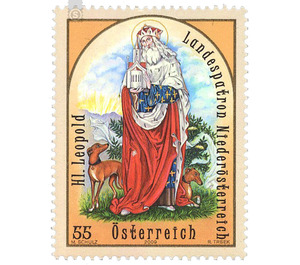patrons - Austria / II. Republic of Austria 2009 - 55 Euro Cent
Theme: Religion & Spirituality
| Country | Austria / II. Republic of Austria |
| Issue Date | 2009 |
| Face Value | 55.00 |
| Edition Issued | 500,000 |
| Printing Type | combination printing |
| Stamp Type | Commemorative |
| Item Type | Stamp |
| Chronological Issue Number | 2177 |
| Chronological Chapter | OOS-OE2 |
| SID | 302360 |
| In 59 Wishlists | |
With Saint Leopold, the patron saint of Lower Austria, the popular brand series "Schutzpatrone" now finds its conclusion. Maria Schulz (draft) and Robert Trsek (engraving) took over the design of this attractive special stamp, as with the entire series. Leopold III, called the Holy, the mild or the pious, lived from 1073 to 1136. He came from the house of the Babenberger, his father was Margrave Leopold II and his mother Ida of Formbach-Ratelnberg. His second marriage was Leopold III. married to Agnes von Waiblingen, the widowed sister of Emperor Heinrich V.; 17 children sprang from this marriage, though not all survived. Two of the sons chose the spiritual status - the famous historian Otto von Freising and the later archbishop of Salzburg Konrad. This schism with the Salians certainly raised the importance of the Babenberger-Haus, which was founded by Leopold III during his margraviate. important royal rights were transferred. Leopold called himself "Princeps Terrae", which already indicated the consciousness of an independent state rule. In 1125 he was in conversation as a candidate for the royal election; However, he refrained from mentioning his advanced age and the fact that he had too many sons, which would have caused problems in the succession. Possible causes were also the lack of power and the consideration of the opponent, his step-son Friedrich von Schwaben. The tomb of Leopold III. is located in the Lower Austrian monastery Klosterneuburg, whose existence is due to him. According to legend, he had it built exactly at the point where a Marian apparition showed him the precious veil of his wife Agnes, who had lost these years earlier on the hunt. Founded in 1108, Klosterneuburg became more and more a residence in the following years. Other monasteries were Stift Heiligenkreuz and Klein-Mariazell - these served primarily evangelization, education, and the development of the still heavily wooded area. Of course, his promotion of the cities also deserves special mention - next to Klosterneuburg and Vienna, above all Krems, which got its own minting mint. On January 6, 1485 Leopold III. canonized; his feast day is November 15th. On the occasion of the so-called translation celebration Klosterneuburg Abbey had worldly festivities such as tournaments, banquets and dances. These joys are still celebrated today, on the feast of Leopoldi, every 15 November. Here, the well-known "Fasselrutschen", which slipped down over the "Thousand Bucket" in the Binderstadel of the pen, enjoys special popularity.


